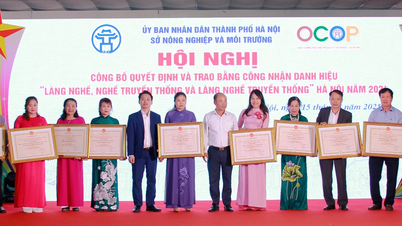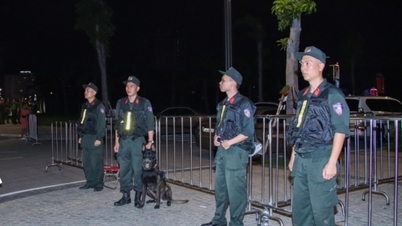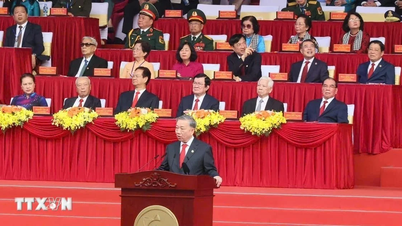Reduce quantity, increase scale, expand development space
The Resolution was just passed by the National Assembly Standing Committee on April 14 at the 44th Session and took effect from today, April 15.
Accordingly, the Resolution stipulates the arrangement of provinces and centrally-run cities (hereinafter referred to as provincial-level administrative units) and the arrangement of communes, wards and towns (hereinafter referred to as commune-level administrative units) in 2025 according to the resolutions and conclusions of the Central Executive Committee, the Politburo and the Secretariat on continuing to arrange the apparatus of the political system, arrange administrative units and organize two-level local governments.
The Resolution also clearly states: the arrangement of provincial-level administrative units stipulated in this Resolution is the merging of provinces with provinces to form new provinces or the merging of provinces with centrally run cities to form new centrally run cities according to the arrangement orientation approved by competent authorities to reduce the number, increase the scale of administrative units, expand development space, and maximize the potential and advantages of localities.

The arrangement of commune-level administrative units stipulated in this Resolution is the establishment, dissolution, merger, division of administrative units, and adjustment of the boundaries of commune-level administrative units to ensure appropriate quantity and scale, the whole country reduces the number of commune-level administrative units by about 60% - 70% compared to the present, meeting the requirements of organizing local government at the commune level close to the people, operating effectively, efficiently, and effectively. In case of arranging wards with administrative units of the same level, the administrative unit formed after the arrangement is the ward; in case of arranging communes and towns, the administrative unit formed after the arrangement is the commune.
8 principles of administrative unit arrangement
The Resolution clearly defines 8 principles for arranging administrative units, including:
Firstly, ensure the leadership of the Party and strengthen the leadership and direction role of heads of agencies and organizations in implementing administrative unit arrangement.
Second, the arrangement of administrative units must comply with the Constitution, the provisions of the Law on Organization of Local Government and this Resolution. In case the arrangement of administrative units is consistent with the orientation approved by the competent authority, it will be assessed as consistent with the relevant planning approved by the competent authority.
Third, the arrangement of provincial and commune-level administrative units is carried out for administrative units whose natural area or population size does not meet the standards of the corresponding administrative unit prescribed in Resolution No. 1211/2016/UBTVQH13 dated May 25, 2016 of the Standing Committee of the National Assembly on standards of administrative units and classification of administrative units, which has been amended and supplemented by a number of articles according to Resolution No. 27/2022/UBTVQH15 dated September 21, 2022 of the Standing Committee of the National Assembly (hereinafter referred to as the Resolution of the Standing Committee of the National Assembly on standards of administrative units and classification of administrative units); have similar historical and cultural traditions; have adjacent geographical locations; have appropriate scale, potential, advantages and level of economic development.
Fourth, the development of plans to rearrange provincial and communal administrative units must take into account factors related to natural conditions, traffic infrastructure, distribution and organization of economic spaces to ensure maximum promotion of the potential and advantages of economic development of each locality, mutual support to promote the overall socio-economic development of the administrative unit after rearrangement; carefully consider factors related to the level and management capacity of local Party committees and authorities, the level of digital transformation, application of information technology by local authorities and people; ensure requirements on national defense and security, build solid defense zones in key areas, island areas, archipelagos and border areas; preserve and promote the historical, cultural and ethnic traditions of each locality; ensure the solidarity of the community.
Fifth, in case of implementing the arrangement of commune-level administrative units that changes the boundaries of district-level administrative units, it is not necessary to follow the procedures for adjusting the boundaries of the district-level administrative units to which the commune-level administrative units belong.
Sixth, link the arrangement of administrative units with innovation, reorganization of the political system to be streamlined, effective and efficient; promote decentralization, delegation of power, enhance autonomy and self-responsibility of local governments; restructure and improve the quality of cadres, civil servants and public employees; ensure that local governments at the commune level are close to the people and serve the people best.
Seventh, when implementing the arrangement of administrative units according to the provisions of this Resolution, the standards on structure and level of socio-economic development, number of affiliated administrative units, type of urban area, level of urban infrastructure development shall not be applied to administrative units formed after the arrangement.
Eighth, focus on and do a good job of propaganda and mobilization of the people to create consensus, support and high unity on the policy of arranging administrative units.
Also according to the Resolution: no arrangement will be made for administrative units with isolated locations or locations of special importance related to national defense, security, and protection of national sovereignty.
Ensure to reduce the number of commune-level administrative units nationwide by 60-70%
The Resolution also sets out some guidelines on the standards of provincial-level administrative units formed after the rearrangement. Specifically, provincial-level administrative units formed after the rearrangement must meet the standards on natural area and population size of the corresponding administrative unit as prescribed in the Resolution of the National Assembly Standing Committee on standards of administrative units and classification of administrative units. In case a province is reorganized to become a centrally-run city, the province formed after the rearrangement must basically meet the standards on natural area and population size of a centrally-run city.
For commune-level administrative units formed after the reorganization, The Resolution clearly states that, based on the principles of administrative unit arrangement stipulated in Article 2 of this Resolution, the Provincial People's Committee is responsible for developing and selecting a plan to arrange commune-level administrative units suitable to the characteristics of rural, urban, island, mountainous, highland, border, plain, and ethnic minority areas and meeting the following orientations:
Mountainous and highland communes formed after the rearrangement have a natural area of 200% or more and a population size of 100% or more of the standards of the corresponding commune as prescribed in the Resolution of the National Assembly Standing Committee on standards of administrative units and classification of administrative units;
Communes formed after the rearrangement not covered by Point a and Point d of this Clause have a population size of 200% or more and a natural area of 100% or more of the standards of the corresponding communes prescribed in the Resolution of the National Assembly Standing Committee on standards of administrative units and classification of administrative units;
Wards formed after the rearrangement have a natural area of 5.5 km2 or more; for wards in centrally-run cities, the population must be 45,000 or more; wards in provinces formed after the rearrangement in mountainous, highland, and border areas must have a population of 15,000 or more; the remaining wards must have a population of 21,000 or more;
The arrangement of commune-level administrative units under district-level administrative units in islands must ensure national defense and security requirements and follow the orientation approved by competent authorities.
Also according to the Resolution, in case of arranging 3 or more commune-level administrative units into 1 new commune or ward, it is not necessary to consider the orientation on standards specified in Clause 1 of this Article.
In case the commune-level administrative unit formed after the rearrangement cannot meet the orientations on standards prescribed in Clause 1 of this Article and does not fall under the cases prescribed in Clause 2 of this Article, the Government shall report to the National Assembly Standing Committee for consideration and decision.
The Government leads and directs the People's Committees of provinces and centrally run cities to develop a project to rearrange commune-level administrative units in their localities to ensure a reduction in the number of commune-level administrative units nationwide according to the ratio prescribed in Clause 3, Article 1 of this Resolution.
The Resolution also stipulates that the name of the provincial-level administrative unit formed after the rearrangement shall be named after one of the administrative units before the rearrangement in accordance with the rearrangement orientation approved by the competent authority.
The naming and renaming of commune-level administrative units must be easy to read, easy to remember, concise, ensure systematicity, scientificity, be consistent with the historical and cultural traditions of the locality and be supported by the local people; it is encouraged to name commune-level administrative units in sequential numbers or according to the names of district-level administrative units (before the arrangement) with sequential numbers attached to facilitate the digitization and updating of information data. The name of a commune-level administrative unit must not be the same as the name of an administrative unit of the same level within the scope of a provincial-level administrative unit or within the scope of a provincial-level administrative unit expected to be formed after the arrangement.
The Resolution also stipulates: procedures, processes, and documents for administrative unit reorganization projects; perfecting the organizational structure and applying specific policies and regimes of administrative units after reorganization...
Source: https://daibieunhandan.vn/chu-tich-quoc-hoi-tran-thanh-man-ky-ban-hanh-nghi-quyet-ve-sap-xep-don-vi-hanh-chinh-nam-2025-post410312.html



![[Photo] Chinese, Lao, and Cambodian troops participate in the parade to celebrate the 50th anniversary of the Liberation of the South and National Reunification Day](https://vphoto.vietnam.vn/thumb/1200x675/vietnam/resource/IMAGE/2025/4/30/30d2204b414549cfb5dc784544a72dee)

![[Photo] The parade took to the streets, walking among the arms of tens of thousands of people.](https://vphoto.vietnam.vn/thumb/1200x675/vietnam/resource/IMAGE/2025/4/30/180ec64521094c87bdb5a983ff1a30a4)

![[Photo] Cultural, sports and media bloc at the 50th Anniversary of Southern Liberation and National Reunification Day](https://vphoto.vietnam.vn/thumb/1200x675/vietnam/resource/IMAGE/2025/4/30/8a22f876e8d24890be2ae3d88c9b201c)















![[Photo] Performance of the Air Force Squadron at the 50th Anniversary of the Liberation of the South and National Reunification Day](https://vphoto.vietnam.vn/thumb/1200x675/vietnam/resource/IMAGE/2025/4/30/cb781ed625fc4774bb82982d31bead1e)






































































Comment (0)